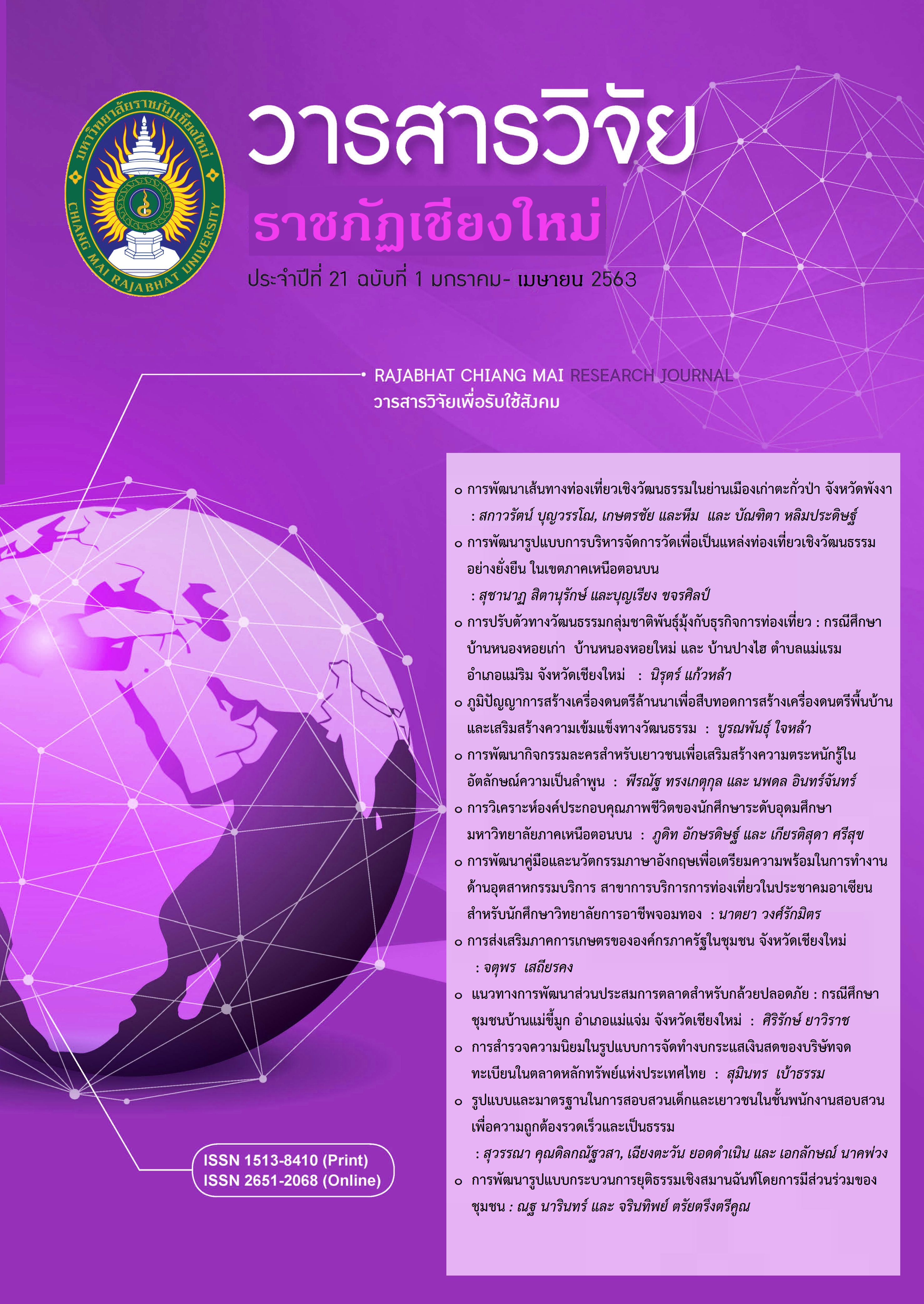Development of Temple Management Model: Sustainable Cultural Tourist Attraction in the Upper North Area, Thailand
DOI:
https://doi.org/10.14456/rcmrj.2020.235921Keywords:
Temple management model, Sustainable cultural tourist attraction, The upper north areaAbstract
The objectives of this research were 1) to develop a temple management model to be a sustainable cultural attraction in the upper north area, Thailand; 2) to implement and evaluate the implementation of the model; and 3) to improve the temple management model. The sample groups were 213 people of the temple abbots, monks, and the temple committee and 200 tourists. The data was collected by using an interview form, questionnaires and satisfaction scale. The data was analyzed by frequency distribution, percentage and mean.
The research results were 1) the temple management model to be a sustainable cultural tourist attraction consisted of 5 factors 1.1) planning; study on temple context, set the objectives and guidelines to practice, and evaluate/review/adjust the plan 1.2) organizing; define the categories of work and decentralize 1.3) staffing; recruit and train people for personnel development 1.4) directing; communicate and use leadership relations 1.5) controlling; monitor/follow-up and edit to achieve the goals 2) the results of implementation and evaluation of the temple management model indicated that the model was appropriated in 3 dimensions. Most people were aware of tourist attractions and environment. The tourists were satisfied with all aspects. Local people had participated in community income and knowledge. The model was improved by adding ‘public relation’ in planning factor.
Downloads
References
กาญจนา แสงลิ้มสุวรรณ และศรันยา แสงลิ้มสุวรรณ. (2555). การท่องเที่ยวเชิงมรดกวัฒนธรรมอย่างยั่งยืน. วารสารนักบริหาร, 32(4), 139-146.
คณะกรรมการนโยบายการท่องเที่ยวแห่งชาติ. (2560). แผนพัฒนาการท่องเที่ยวแห่งชาติ ฉบับที่ 2 (พ.ศ. 2560 - 2564). กรุงเทพมหานคร: สำนักงานกิจการโรงพิมพ์องค์การสงเคราะห์ทหารผ่านศึก.
บุญเลิศ จิตตั้งวัฒนา และเพ็ญศิริ ศรีคำภา. (2557). การพัฒนาการท่องเที่ยวแบบยั่งยืน. (พิมพ์ครั้งที่ 2). นนทบุรี: บริษัท ธรรมสารจำกัด.
พระธรรมโกศาจารย์ (ประยูร ธมฺมจิตฺโต). (2549). พุทธวิธีบริหาร. กรุงเทพมหานคร: โรงพิมพ์มหาจุฬาลงกรณราชวิทยาลัย.
วรพล วัฒนเหลืองอรุณ, กริช สอิ้งทอง และอัศวินี ไชยวุฒิ. (2562). การศึกษาเอกลักษณ์เพื่อการท่องเที่ยวบนพื้นฐานของการจัดการท่องเที่ยวอย่างยั่งยืน พื้นที่ อำเภอแม่ริม จังหวัดเชียงใหม่. วารสารวิจัยราชภัฏเชียงใหม่, 20(2), 53-68.
สำนักงานคณะกรรมการพัฒนาระบบราชการ (ก.พ.ร.) . (2560). การบริหารราชการแบบมีส่วนร่วม: เทคนิควิธีและการนำไปสู่การปฏิบัติ. (พิมพ์ครั้งที่ 1). กรุงเทพมหานคร: ศูนย์สื่อและสิ่งพิมพ์แก้วเจ้าจอม มหาวิทยาลัยราชภัฏสวนสุนันทา.
Goeldner, R., & Ritchie, J. (2008). Tourism: principle, practice, philosophies. (11thed.). Hoboken, NJ: John Wiley & Sons.
Nation TV. (2558). ยูเนสโก้ขึ้นบัญชี “เชียงใหม่” รอประกาศเป็น “มรดกโลก”. สืบค้นจาก https://www.nationtv.tv/main/content/social/378465017/
Downloads
Published
How to Cite
Issue
Section
License
1. Articles, information, content, images, etc published in the “Community and Social Development Journal” are copyrighted by the Community and Social Development Journal, Chiang Mai Rajabhat University. In order to properly distribute the articles through print and electronic media, the authors still hold the copyright for the published articles under the Creative Commons Attribution (CC BY) license, which allows the re-distribution of the articles in other sources. References must be made to the articles in the journal. The authors are responsible for requesting permission to reproduce copyrighted content from other sources.
2. The content of the articles appearing in the journal is the direct responsibility of the article authors. The editorial board of the journal does not necessarily agree with or share any responsibility.














